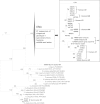Subtyping novel zoonotic pathogen Cryptosporidium chipmunk genotype I
- PMID: 25762767
- PMCID: PMC4400750
- DOI: 10.1128/JCM.03436-14
Subtyping novel zoonotic pathogen Cryptosporidium chipmunk genotype I
Abstract
Cryptosporidium chipmunk genotype I is an emerging zoonotic pathogen in humans. The lack of subtyping tools makes it impossible to determine the role of zoonotic transmission in epidemiology. To identify potential subtyping markers, we sequenced the genome of a human chipmunk genotype I isolate. Altogether, 9,509,783 bp of assembled sequences in 853 contigs were obtained, with an N50 of 117,886 bp and >200-fold coverage. Based on the whole-genome sequence data, two genetic markers encoding the 60-kDa glycoprotein (gp60) and a mucin protein (ortholog of cgd1_470) were selected for the development of a subtyping tool. The tool was used for characterizing chipmunk genotype I in 25 human specimens from four U.S. states and Sweden, one specimen each from an eastern gray squirrel, a chipmunk, and a deer mouse, and 4 water samples from New York. At the gp60 locus, although different subtypes were seen among the animals, water, and humans, the 15 subtypes identified differed mostly in the numbers of trinucleotide repeats (TCA, TCG, or TCT) in the serine repeat region, with only two single nucleotide polymorphisms in the nonrepeat region. Some geographic differences were found in the subtype distribution of chipmunk genotype I from humans. In contrast, only two subtypes were found at the mucin locus, which differed from each other in the numbers of a 30-bp minisatellite repeat. Thus, Cryptosporidium chipmunk genotype I isolates from humans and wildlife are genetically similar, and zoonotic transmission might play a potential role in human infections.
Copyright © 2015, American Society for Microbiology. All Rights Reserved.
Figures


References
Publication types
MeSH terms
Substances
Associated data
- Actions
- Actions
- Actions
- Actions
- Actions
- Actions
- Actions
- Actions
- Actions
- Actions
- Actions
- Actions
- Actions
- Actions
- Actions
- Actions
- Actions
- Actions
- Actions
- Actions
- Actions
LinkOut - more resources
Full Text Sources
Molecular Biology Databases

